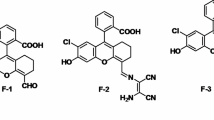Abstract
A novel fluorescein-based dual probe was designed and synthesized. The probe exhibited highly sensitive and selective colormetric response to Fe3+ and turn-on fluorescence response towards OCl− with very low detection limits of 100 and 50 nM, respectively. It was successfully applied for quantitative detection of Fe3+ and OCl− in real water samples. Moreover, probe 1 was expected to be a potentially powerful tool for studying and providing further insights into OCl− and Fe3+ chemistry in the near future.









Similar content being viewed by others
References
Winter J, Ilbert M, Graf PCF, Özcelik D, Jakob U (2008) Bleach activates a redox-regulated chaperone by oxidative protein unfolding. Cell 135(4):691–701
Shepherd J et al (2007) A fluorescent probe for the detection of myeloperoxidase activity in atherosclerosis-associated macrophages. Chem Biol 14(11):1221–1231
Ray PD, Huang B-W, Tsuji Y (2012) Reactive oxygen species (ROS) homeostasis and redox regulation in cellular signaling. Cell Signal 24(5):981–990
Winterbourn CC, Hampton MB, Livesey JH, Kettle AJ (2006) Modeling the reactions of superoxide and myeloperoxidase in the neutrophil phagosome: implications for microbial killing. J Biol Chem 281(52):39860–39869
Hentze MW, Muckenthaler MU, Andrews NC (2004) Balancing acts: molecular control of mammalian iron metabolism. Cell 117(3):285–297
Domaille DW, Que EL, Chang CJ (2008) Synthetic fluorescent sensors for studying the cell biology of metals. Nat Chem Biol 4(3):168–175
Lee J-W, Helmann JD (2006) The PerR transcription factor senses H2O2 by metal-catalysed histidine oxidation. Nature 440(7082):363–367
Rouault TA, Tong W-H (2005) Iron-sulphur cluster biogenesis and mitochondrial iron homeostasis. Nat Rev Mol Cell Biol 6(4):345–351
Swaminathan S, Fonseca VA, Alam MG, Shah SV (2007) The role of iron in diabetes and its complications. Diabetes Care 30(7):1926–1933
Zecca L, Youdim MBH, Riederer P, Connor JR, Crichton RR (2004) Iron, brain ageing and neurodegenerative disorders. Nat Rev Neurosci 5(11):863–873
Zhou J, Ma H (2016) Design principles of spectroscopic probes for biological applications. Chem Sci 7(10):6309–6315
Sun W, Guo S, Hu C, Fan J, Peng X (2016) Recent development of chemosensors based on cyanine platforms. Chem Rev 116(14):7768–7817
Jung HS, Verwilst P, Kim WY, Kim JS (2016) Fluorescent and colorimetric sensors for the detection of humidity or water content. Chem Soc Rev 45(5):1242–1256
Chen X et al (2016) Recent progress in the development of fluorescent, luminescent and colorimetric probes for detection of reactive oxygen and nitrogen species. Chem Soc Rev 45(10):2976–3016
Chu T-S, Lü R, Liu B-T (2016) Reversibly monitoring oxidation and reduction events in living biological systems: recent development of redox-responsive reversible NIR biosensors and their applications in in vitro/in vivo fluorescence imaging. Biosens Bioelectron 86:643–655
Guan M et al (2017) Study of fluorescent imaging of Se (IV) in living cells using a turn-on fluorescent probe based on a rhodamine spirolactame derivative. J Fluoresc 27(2):611–618
Sharma N et al (2017) A highly selective fluorescent probe for Fe3+ in living cells: a stress induced cell based model study. Org Biomol Chem 15(4):1006–1012
Yang X et al (2016) A differentially selective probe based on diketopyrrolopyrrole with fluorescence turn-on response to Fe3+, and dual-mode turn-on and ratiometric response to Au3+, and its application in living cell imaging. Biosens Bioelectron 80:288–293
Rasheed L et al (2015) Turn-on ratiometric fluorescent probe for selective discrimination of Cr3+ from Fe3+ in aqueous media for living cell imaging. Chem Eur J 21(46):16349–16353
Zhao M et al (2016) 2-(1-Pyrenyl) benzimidazole as a ratiometric and “turn-on” fluorescent probe for iron(iii) ions in aqueous solution. Analyst 141(7):2308–2312
Qiao L et al (2017) An ultrafast responsive BODIPY-based fluorescent probe for the detection of endogenous hypochlorite in live cells. J Mater Chem B 5(3):525–530
Zhou X-H, Jiang Y-R, Zhao X-J, Guo D (2016) A naphthalene-based two-photon fluorescent probe for selective and sensitive detection of endogenous hypochlorous acid. Talanta 160:470–474
Zhao C et al (2016) Transforming the recognition site of 4-hydroxyaniline into 4-methoxyaniline grafted onto a BODIPY core switches the selective detection of peroxynitrite to hypochlorous acid. Chem Commun (Camb) 52(10):2075–2078
Zhang R et al (2016) Real-time discrimination and versatile profiling of spontaneous reactive oxygen species in living organisms with a single fluorescent probe. J Am Chem Soc 138(11):3769–3778
Xu Q et al (2016) A selective imidazoline-2-thione-bearing two-photon fluorescent probe for hypochlorous acid in mitochondria. Anal Chem 88(12):6615–6620
Jin X, Jia Y, Chen W, Chui P, Yang Z (2016) A reaction-based fluorescent probe for rapid detection of hypochlorite in tap water, serum, and living cells. Sensors Actuators B 232:300–305
Jin X et al (2013) Two novel fluorescein-based fluorescent probes for hypochlorite and its real applications in tap water and biological imaging. Sensors Actuators B 186:56–60
Yang X-F, Li Y, Bai Q (2007) A highly selective and sensitive fluorescein-based chemodosimeter for Hg2+ ions in aqueous media. Anal Chim Acta 584(1):95–100
Acknowledgements
The work was supported by the National Natural Science Foundation of China (No. 21202130, 51603164), the Fundamental Research Funds for the Central Universities (No.3102014JCQ15005), the Natural Science Foundation Research Project of Shaanxi Province(No.2015JM2067), the president Foundation of Xi’an Technological University (No. XAGDXJJ16010).
Author information
Authors and Affiliations
Corresponding authors
Additional information
Xilang Jin and Xianglong Wu contributed equally to this work.
Electronic Supplementary Material
Below is the link to the electronic supplementary material.
Rights and permissions
About this article
Cite this article
Jin, X., Wu, X., Liu, L. et al. Dual-Functional Fluorescein-Based Chemosensor for Chromogenic Detection of Fe3+ and Fluorgenic Detection of HOCl. J Fluoresc 27, 2111–2117 (2017). https://doi.org/10.1007/s10895-017-2150-y
Received:
Accepted:
Published:
Issue Date:
DOI: https://doi.org/10.1007/s10895-017-2150-y




